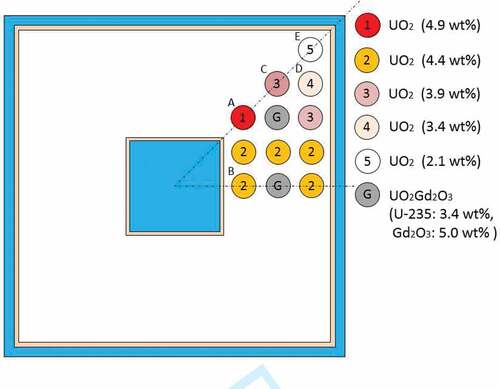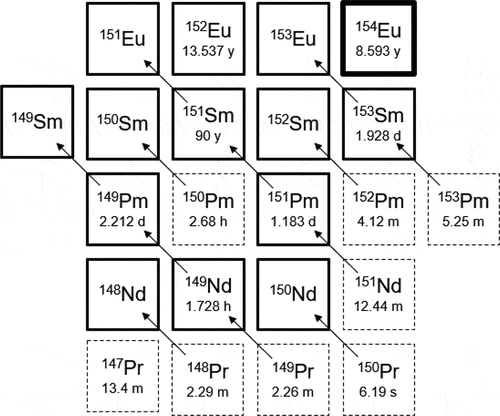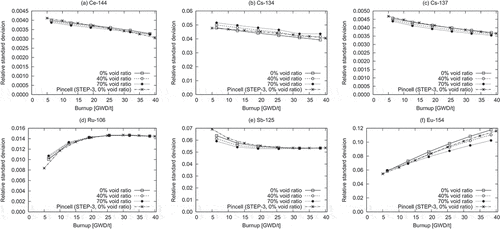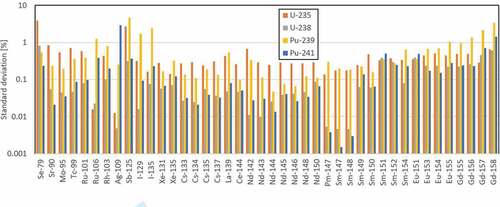 ?Mathematical formulae have been encoded as MathML and are displayed in this HTML version using MathJax in order to improve their display. Uncheck the box to turn MathJax off. This feature requires Javascript. Click on a formula to zoom.
?Mathematical formulae have been encoded as MathML and are displayed in this HTML version using MathJax in order to improve their display. Uncheck the box to turn MathJax off. This feature requires Javascript. Click on a formula to zoom.ABSTRACT
The passive gamma spectroscopy (PGS) is a useful technique to extract information on spent nuclear fuels without any destructive actions. This method requires a correlation between number densities (NDs) of target nuclides, and it is generally estimated by numerical simulation. Therefore, the prediction accuracy of these nuclide generations is one of the key issues in PGS. Nuclear data used in nuclear fuel depletion calculations is one of the dominant uncertainty sources, so we quantify nuclear data-induced uncertainties of NDs of six fission product nuclides, which are important in PGS: Ce-144, Cs-134, −137, Ru-106, Sb-125, and Eu-154. Generation mechanisms of these nuclides are quantitatively investigated through sensitivities of these NDs to nuclear data. With the sensitivities and covariance data of nuclear data, uncertainties of NDs of these nuclides are quantified. The uncertainties of Ce-144, Cs-137, and Ru-106 are less than 2%, and that of Sb-125 is around 6%. In these uncertainties, fission yield uncertainties are dominant. On the Cs-134 and Eu-154 generations, total uncertainties are around 5% and uncertainties of (n,) cross-sections are dominant.
1. Introduction
Spent (or irradiated) nuclear fuels should be composed of various radioactive nuclides including fission product (FP) nuclides. FP nuclides are generated by nuclear fission reactions, and their generation probabilities are inherently determined dependent on fissile nuclides originating the fission reaction and energy of neutron inducing the fission reaction. Thus, the amounts of FP nuclides in spent fuels should include quite useful information to know the characteristics about the spent fuels. The amount of radioactive nuclides in a material can be quantified by measuring gamma-rays emitted through radioactive decay of these nuclides. If gamma-rays emitted from concerned radioactive nuclides are measurable, the amount of these nuclides can be quantified, and these can be utilized to extract the information about the material. This technique to quantify the amount of radioactive nuclides in a material through measuring emitted gamma-rays is widely known as the gamma spectroscopy, and if gamma-rays are measured without any actions like neutron injections to this material, this is referred to as the passive gamma spectroscopy.
Some FP nuclides are accumulated linearly with respect to fuel burnup, so if the total amount of these FP nuclides included in a spent fuel can be quantified, fuel burnup of this spent fuel can be estimated. Such FP nuclides are called a burnup indicator, and Cs-137 is a well-known one [Citation1]. Also, even if the total amount of FP nuclides cannot be quantified, if a ratio of the amounts of two FP nuclides, of which one is accumulated quadratically (linearly) and the other is linearly (almost constant) with fuel burnup, can be quantified, fuel burnup can be estimated also from this ratio because this ratio should be linearly dependent on fuel burnup. Radioactivity ratios of Cs-134/Cs-137, Eu-154/Cs-137 and Ru-106/Ce-144 are those examples [Citation1]. The passive gamma spectroscopy focusing on these FP nuclides can be utilized to quantify fuel burnup.
The passive gamma spectroscopy can be applied also to quantification of inventories of special nuclear materials like uranium and plutonium in spent fuels from a viewpoint of no diversion of these materials. It becomes possible by measuring gamma-ray emitted from not the target nuclides but measurable nuclides, and by using a correlation between number densities of this measurable nuclide and the target nuclide of special nuclear materials.
Generally, these information such as fuel burnup and nuclide inventories can be accurately estimated by numerical simulations for spent fuels in normal nuclear power plants. However, when a severe accident accompanying core melting occurs in a nuclear power plant, it becomes quite difficult to specify the irradiation history of melted fuels. In such cases, the passive gamma spectroscopy is a powerful tool, and it was applied to the decommissioning process of the Three Mile Island’s unit 2 reactor [Citation2] where FP nuclides such as Cs-134, −137, Ce-144, Eu-154, Ru-106 and Sb-125 were concerned. In addition, the possibility of the application of the passive gamma spectroscopy to the decommissioning for the Fukushima Dai-ichi power plant has been recently discussed [Citation3].
In the methods of nuclide inventory quantification with the passive gamma spectroscopy, correlations between number densities of some specific nuclides should be prepared, and results of numerical simulations are generally used. Thus, one of the important points in these methods is the prediction accuracy of inventories of the concerned nuclides. In numerical simulations for nuclide inventories, several uncertain sources should be considered, and one of the dominant sources is nuclear data, which describes the interaction of neutrons with nuclides. Recently a lot of works about nuclear data-induced uncertainty quantification in nuclide inventories have been carried out, and relevant methods and tools have been developed. Among these activities, the work being conducted at Hokkaido University is quite unique; it is based on the sensitivity-based procedure, in which importance functions for concerned nuclide inventories are defined and calculated in a complicated system like a light water reactor (LWR) fuel assembly [Citation4]. With the advanced methods and tools developed through these activities, it becomes possible now to clearly understand the mechanism of nuclide generation during nuclear fuel depletion by calculating sensitivities of nuclide inventories with respect to relevant nuclear data. Furthermore, by using these sensitivities it also becomes possible to quantify nuclear data-induced uncertainties of these nuclide inventories using uncertainty information on nuclear data: covariance data of nuclear data.
In the present work, we focus on the generation of six FP nuclides in uranium-dioxide-loaded boiling water reactor (BWR) fuel assemblies. These nuclides are Ce-144, Cs-134, −137, Ru-106, Sb-125 and Eu-154, and are important in the passive gamma spectroscopy.
Generation mechanism is quantitatively investigated by sensitivity analyses, and by using these sensitivities and the covariance data, nuclear data-induced uncertainties of these nuclide inventories are quantified.
Section 2 describes the basic data, theory, and procedure about sensitivity analyses and uncertainty quantification for nuclide number densities during nuclear fuel depletion. Section 3 presents problem specifications for nuclear fuel depletion and all the numerical results, and the conclusion is given in Section 4. Also, in the appendix, an additional study about covariance matrix generation methods of fission yield data is presented.
2. Data, theory and procedure of sensitivity analyses and uncertainty quantification
2.1. Nuclear data and their covariance data
When nuclide generations in nuclear fuels during irradiation or nuclear reactor operation are concerned, numerical calculations about nuclear fuel depletion can be employed. Nuclear data relevant to (or used in) nuclear fuel depletion calculations are enormous: neutron-nuclide reaction cross-sections, reaction branching ratios, fission yields, radioactive decay-relevant data such as decay constants and decay branching ratios, etc. In the present study, uncertainties of reaction cross-sections, fission yields, decay constants, and decay branching ratios are taken into account. Generally, uncertainty information on these nuclear data is provided as covariance data in evaluated nuclear data libraries. We will use the evaluated nuclear data libraries JENDL-4.0 [Citation5], JENDL/FPY-2011 (revised version), and JENDL/FPD-2011 [Citation6,Citation7] for reaction cross-sections, fission yields, and decay-relevant nuclear data, respectively.
In JENDL-4.0, covariance data are evaluated for almost all the important actinoid nuclides, and those are taken into account in the present study. However, JENDL-4.0 provides no covariance data for reaction cross-sections of FP nuclides, so we will use tentatively covariance data for some important FP nuclides taken from the newest version of the US library, ENDF/B-VIII.0 [Citation8]. In the following uncertainty quantification calculations, covariance data of reaction cross-sections will be used together with sensitivities in multi-group representations, so covariance data in multi-group representation, obtained with the NJOY-99 code [Citation9], are used.
In JENDL/FPY-2011, fission yield data are given to 1,299 FP nuclides. Only variance data are provided to fission yield data in JENDL/FPY-2011 due to the format limitation, but it has been pointed out by many authors that correlations in fission yield data among different nuclides should be taken into account to properly conduct uncertainty propagation calculations [Citation6,Citation10]. While there have been several methods to take into account the correlations, we will adopt the generalized least-square (GLS) updating procedure introducing information about chain yields and some physical constraints about fission reactions [Citation10]. Detail of the GLS updating procedure will be described in the appendix. There is another simple method based on a single mass chain proposed by Devillers [Citation11], and a difference between these two methods and its impact will be discussed also in the appendix. On the decay branching ratio, correlations due to the physical constraints (normalization condition) are taken into account.
2.2. Sensitivity calculations with the depletion perturbation theory
In the present work, we will handle with a sensitivity of nuclide number density with respect to nuclear data in BWR single pincell models and a BWR assembly model. When a number density of nuclide at specific burnup and nuclear data
are denoted to as
and
, respectively, a sensitivity of
to
,
, is defined as
Sensitivities are very useful to understand the mechanism of nuclide generation during nuclear fuel depletion. For example, on FP nuclide generation, origins of the concerned FP nuclide can be specified by observing sensitivities of this nuclide number density with respect to fission yield data.
Since quite a large number of nuclear data are used in nuclear fuel depletion calculations as mentioned above, numerical differentiation to obtain is unrealistic. In the field of reactor physics, the generalized perturbation theory for nuclear fuel depletion problems, depletion perturbation theory (DPT), has been developed and well established [Citation12,Citation13]. Since the seminal works cited here, the applicability of DPT has been enhanced, and now this theory can be applied to nuclear fuel depletion problems of LWR fuel assemblies including burnable absorbers [Citation4].
In the present work, we will use DPT to calculate sensitivities of number densities of concerned nuclides during nuclear fuel depletion with respect to nuclear data such as neutron-nuclide reaction cross-sections, fission yields, decay constants, and decay branching ratios. A brief description of DPT is provided in the following.
Let us consider a nuclear fuel depletion calculation, and nuclide number densities of this fuel at time are represented by a vector as
. We assume that an initial condition of the nuclide number density is provided at
. Usually, we divide the whole depletion time period into several time steps, and a burnup matrix is assumed constant during each time step. When we divide the period into
time steps, the following burnup equation can be defined:
where is a burnup matrix of step
, and is defined from microscopic cross-sections and neutron flux at
. The neutron flux at
,
, is defined from the following neutron transport equation:
where the operator is defined from
.
A sensitivity of number density of nuclide at
,
, with respect to a nuclear data
can be calculated with the following equation:
Note that it is assumed here that neutron flux normalization does not depend on any reaction cross-sections for simplicity.
In EquationEquation (4)(4)
(4) , a vector
represents adjoint number densities, and is defined as
with a final condition . Note that
is a vector having the
th component of unity with all other components zero. At boundaries between subsequent time steps, discrete changes known as jump condition should be considered for
, but its detail is omitted here. A generalized adjoint neutron flux represented as
in EquationEquation (4)
(4)
(4) is defined as
Detail of the source term is also omitted here.
Numerical calculations of nuclide number densities with DPT are generally based on numerical methods for nuclear fuel depletion calculations, which consist of neutron flux distribution calculations by solving the neutron transport equation and nuclide transmutation calculations. In the present study, all these calculations are carried out with a reactor physics code system CBZ [Citation14] which has been developed at Hokkaido University.
In nuclear fuel depletion calculations, generation and transmutation of FP nuclides should be numerically simulated. Since there are a large number of FP nuclides over 1,000, it is computationally heavy to treat all these FP nuclides explicitly in nuclides transmutation calculations especially in a complicated system like LWR fuel assemblies. Furthermore, this issue about computational burden becomes serious when the DPT calculations are carried out since a huge amount of data during nuclear fuel depletion should be stored. In order to solve these problems, two types of fuel depletion calculations are carried out in the present study. The first one is to use a detailed nuclide chain model in which all the FP nuclides are explicitly treated, and the second one is to use a simplified nuclide chain model in which a limited number of important FP nuclides are treated. In the second type of calculations, we use a chain model consisting of 197 FP nuclides; 193 nuclides of which are chosen in one of the FP transmutation chain model adopted in the SRAC-2006 code [Citation15] and the following four nuclides are added: Nd-149, Sn-125, I-133, and Gd-153. This nuclide chain is one of generally used ones in LWR fuel depletion analyses with CBZ.
For resonance calculations, the advanced Bondarenko method [Citation16] is adopted, and medium-wise 107-group cross-section data are generated. In fuel assembly calculations, background cross-sections required in the advanced Bondarenko method are calculated from the Dancoff factors evaluated with the whole-assembly model [Citation17]. Neutron transport calculations with the 107-group cross-sections including generalized adjoint neutron flux calculations for DPT are performed with a neutron transport calculation module MEC based on the method of characteristics, and reaction rates are calculated for all the media containing nuclear fuels. Scattering anisotropy is taken into account by the P0 transport approximation.
Nuclide transmutation calculations are carried out with the reference detailed chain model or the simplified chain model as mentioned above. Nuclide transmutation equations including adjoint problems in DPT are solved by the matrix exponential method with the mini-max polynomial approximation method [Citation18,Citation19]. For LWR assembly calculations, the predictor-corrector method is employed.
2.3. Uncertainty quantification with sensitivities and covariance data
Nuclear data-induced uncertainties of nuclide number densities can be easily quantified if sensitivities of nuclide number densities with respect to nuclear data are available. Nuclear data-induced uncertainty of (a variance of
),
, can be calculated with the following equation:
where is a covariance between
and
, and a covariance matrix covering all the nuclear data considered is defined as
. When we define a sensitivity vector
as
, where
is the total number of concerned nuclide number densities, and
is for vector and matrix transposition, using
and
,
can be rewritten as
Covariance between and
,
, can be also calculated as
and a covariance matrix covering all the concerned number densities, , can be calculated as
where , where
is the total number of nuclear data considered.
When the simplified chain model is used, sensitivities of nuclide number densities to nuclear data are calculated within the framework of this simplified chain model, so in uncertainty quantification calculations with sensitivities and covariance data, covariance data which is consistent with this simplified chain model should be used. This issue has been discussed, and the numerical method and tool have been already established in our previous work [Citation20]. Its detail is omitted here, but in the present work, we will follow this previous work.
3. Numerical results
3.1. Problems specification
In the present study, we focus on a set of BWR single pincell models and a BWR fuel assembly model.
We use two of the BWR pincell models developed for cross-section data library generation for the ORIGEN code [Citation21]: a model based on the STEP-1 assembly and a model based on the STEP-3 assembly. Geometric specifications and U-235 enrichments are different from each other as shown in . Power density is set to 25.6 MW/tU, and 0% void ratio for coolant is assumed. To see the impact of the void condition on calculation results, 70% void ratio condition is also considered for the STEP-3 model. Therefore, totally three conditions will be treated as the BWR pincell models.
Table 1. Specifications of BWR single pincell models
About a BWR fuel assembly model, we will use the model developed through the OECD/NEA burnup credit benchmark phase-IIIC [Citation22]. This model is based on a typical 99-type BWR assembly. Its horizontal geometrical specification is shown in . The power density is set to 25.3 MW/tU, and three different void ratio conditions, 0%, 40%, and 70%, are treated.
3.2. Sensitivity calculations with pincell problems
First, in order to specify the origins of the target FP nuclide generations, sensitivities of nuclide number densities at several fuel burnups to fission yields are calculated in the pincell problem of STEP-3 with 0% void ratio. In order to ease understanding, the simplified chain model consisting of 197 FP nuclides is used here, so contributions of short-lived FP nuclides are taken into account indirectly via their daughter nuclides treated in the simplified chain model.
Among six target nuclides, no neutron-nuclide reactions contribute to the generations of Ce-144, Cs-137, Ru-106, and Sb-125: those nuclides are accumulated by a fission reaction and subsequent radioactive decays in the specific decay chain. About the Cs-134 generation, the contribution of (n,) reaction of Cs-133 is dominant rather than the contribution from the decay chain to which Cs-134 is belonging; this means that the Cs-134 generation has a large sensitivity to fission yields of FP nuclides in the decay chain to which Cs-133 is belonging. Whereas these generation mechanisms are quite simple and have been well known, the generation mechanism of Eu-154 is much more complicated than the others. These will be described later in this section.
shows sensitivities of number densities of the target six nuclides at several fuel burnups to fission yield data. This figure shows sensitivities summed up over all the FP nuclides for each fissile nuclide occurring fission reactions. Generally, FP nuclides generated by U-235 have large sensitivity at the beginning of the depletion, but the contribution of Pu-239 becomes large as fuel burnup increases. The Pu-239 contributions are relatively large in the cases of Ru-106 and Sb-125.
Figure 2. Sensitivity of nuclides generation to fissile nuclide-wise fission yields (STEP-3, 0% void ratio)

As mentioned above, only Eu-154 generation shows complicated sensitivity profiles for fission yield data. shows sensitivities of Eu-154 number density to FP nuclide-wise fission yields. This figure shows that fission yields of FP nuclides whose mass number is different from 154 have large sensitivities, and sensitivities of FP nuclides with low mass number become large as fuel burnup increases. This means that multiple (n,) reactions are important in the Eu-154 generation.
Figure 3. Sensitivity of Eu-154 generation to FP nuclide-wise fission yields (STEP-3, 0% void ratio)
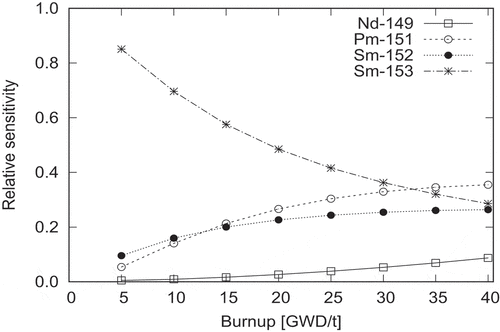
Next sensitivities of Eu-154 number density to one-group (n,) cross-section are shown in . Note that the present DPT calculations yield sensitivities of nuclide number densities to cross-sections in 107-group representation. To summarize this, one-group cross-section sensitivity, which is obtained by summing up sensitivities of all the energy groups, is presented here. This figure shows that (n,
) cross-sections of several nuclides such as Eu-153, −154, and Sm-152 have large sensitivities. Note that among these three nuclides, covariance data are not evaluated for Eu-154 (and Sm-150 also) in ENDF/B-VIII.0. This will be discussed later. Based on these sensitivities, the generation mechanism of Eu-154 can be simply presented as shown in . In this figure, FP nuclides which are explicitly treated in the simplified chain model are shown with bold-line boxes, and those which are neglected are shown with dashed-line boxes. Half-lives of unstable nuclides are also presented inside the boxes.
Figure 4. Sensitivity of Eu-154 generation to FP one-group (n,) cross-sections (STEP-3, 0% void ratio)

Sensitivities of number densities of Ce-144, Cs-134, −137, Ru-106, and Sb-125 at 40 GWD/t to one-group (n,) cross-sections are shown in . This table shows that (n,
) cross-sections of these nuclides do not affect their own number densities, and that only Cs-133 (n,
) cross-section is important among them.
Table 2. Sensitivities of nuclide number densities to one-group (n,) cross-section
3.3 Uncertainty quantification calculations
Uncertainties of nuclide number densities during nuclear fuel depletion are calculated from sensitivities and covariance data with the pincell models. In this calculation, the detailed chain model is used, and three different conditions are considered. Total uncertainties are shown in . Uncertainties of Ce-144 and Cs-137 are small and less than 0.5% during nuclear fuel depletion. Uncertainty of Ru-106 is around 1.5%, and those of the other nuclides, Cs-134, Sb-125, and Eu-154 are around several percentages. Generally, uncertainties are not significantly dependent on the conditions including fuel burnup. Only the uncertainty of Eu-154 is significantly dependent on fuel burnup.
Figure 6. Relative standard deviations of nuclide number densities during nuclear fuel depletion with several conditions
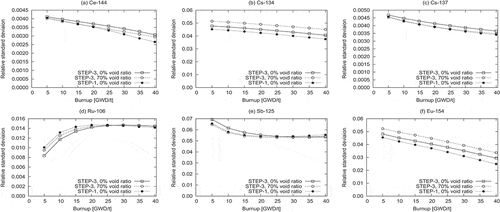
Next, the uncertainties of nuclide number densities in the model of STEP-3 with 0% void ratio are decomposed to nuclear data-wise uncertainties. This kind of evaluation can be easily realized in uncertainty quantification using sensitivity profiles. The results are shown in . Fission yield data are dominant uncertainty sources in the number densities of Ce-144, Cs-137, Ru-106, and Sb-125, and reaction cross-section data are dominant in those of Cs-134 and Eu-154.
The fission yields-induced uncertainty in Sb-125 number density is much larger than the others, and this can be understood by comparing uncertainties given to the cumulative fission yields in JENDL/FPY-2011 as shown in . Note that fissile-wise contributions in fission-yields-induced uncertainties are presented in the appendix.
Figure 7. Component-wise relative standard deviations of nuclide number densities (STEP-3, 0% void ratio)
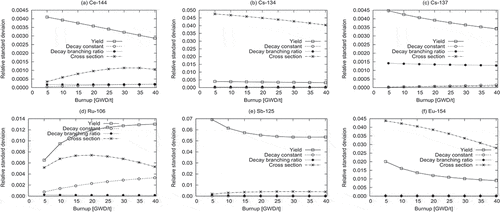
Table 3. Relative standard deviations of cumulative fission yields in JENDL/FPY-2011 (unit: %)
On the Cs-134 number density, Cs-133 (n,) cross-section is a dominant contributor to the total uncertainty. On the Eu-154 number density, Eu-153 and Sm-152 (n,
) cross-sections are dominant contributors to the total uncertainty. It should be reminded here that the covariance data for Eu-154 (n,
) cross-section are not evaluated in ENDF/B-VIII.0 whereas this cross-section is quite sensitive to the Eu-154 number densities. To quantify an impact of the Eu-154 (n,
) cross-section uncertainty on the Eu-154 number density, covariance data of this cross-section are taken from the TENDL-2019 library [Citation23], and uncertainty of Eu-154 number density is recalculated. The result is shown in . When the covariance data of Eu-154 (n,
) cross-section are considered, the uncertainty of Eu-154 number densities becomes much larger than the preceding results. shows nuclide-wise uncertainties of Eu-154 number densities induced by (n,
) cross-sections. This suggests a possibility that the uncertainty of Eu-154 (n,
) cross-section has a large impact on the Eu-154 number densities.
Figure 8. Relative standard deviations of Eu-154 number densities with and without the TENDL-2019 covariance data (STEP-3, 0% void ratio)
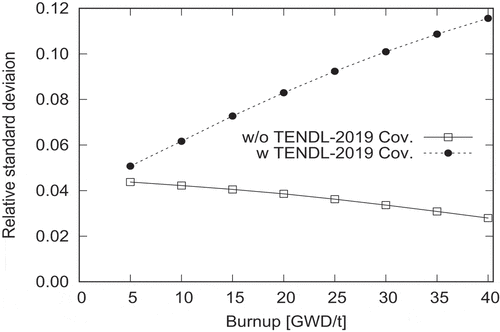
Figure 9. Nuclide-wise contribution in relative standard deviations of Eu-154 number densities induced by (n,) cross-section uncertainties (STEP-3, 0% void ratio)
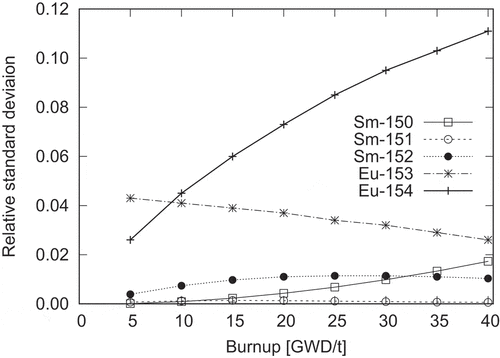
Correlations are also calculated among different conditions and different burnups for each target nuclide. If strong correlations can be observed among different conditions/burnups, uncertainty quantification calculations can be done for one representative model, and this result can be used for extrapolation to different conditions/burnups. On the other hand, if correlations are weak, results should be dependent on used covariance data and the adequate extrapolation cannot be expected. The results are shown in . Note that the TENDL-2019 covariance data are used in this calculation. Parameters whose indices are from 1 to 8 are number densities of the STEP-3 model with 0% void ratio, those from 9 to 16 are of the STEP-3 model with 70% void ratio, and those from 17 to 24 are of the STEP-1 model with 0% void ratio. The parameters 1, 2, …, 8 are number densities at 5 GWD/t, 10 GWD/t, …, 40 GWD/t, and these arrangements are the same as for the parameters from 9 to 16, and those from 17 to 24. Generally there exist positive correlations among number densities of the same nuclide in different conditions and fuel burnups since a limited and specific nuclear data contribute to the uncertainties as mentioned above. Correlations among different conditions are generally quite strong, so one representative model can be chosen and used to uncertainty quantification calculations of number densities of these nuclides. As for the correlations among different fuel burnups, number densities of Ce-144, Cs-134, −137 and Ru-106 are generally strong since dominant contributors to total uncertainties are not significantly dependent on fuel burnup. On the other hand, the uncertainties of number densities of Sb-125 and Eu-154 are significantly dependent on fuel burnup, so these should be paid attention in the actual uncertainty quantification work.
Figure 10. Correlation matrices of nuclide number densities among different conditions and different burnups
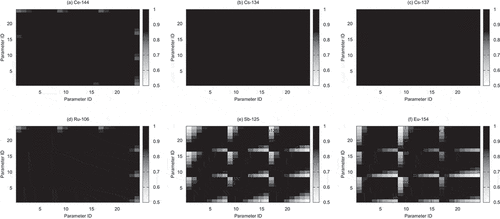
Finally, uncertainty quantification calculations of the number densities of these six target nuclides are carried out with the BWR fuel assembly model. Here, averaged number densities over the whole assembly are concerned, and uncertainties are quantified at different fuel burnups and void ratios. In the whole-assembly fuel depletion calculations including DPT calculations, the use of the reference detailed chain model is unrealistic from a viewpoint of computational time and memory requirement, so the simplified chain model and corresponding covariance data are adopted. Total uncertainties of the assembly-averaged number densities are shown in with those of the pincell model of STEP-3 with 0% void ratio. The impact of void ratios on uncertainties of assembly-averaged number densities is very small, and the difference in the uncertainties between the pincell model and the assembly model is negligible. These results suggest that a simple single pincell model can be utilized for uncertainty quantification calculations of number densities of the target six nuclides rather than the assembly model which requires heavy computational burden.
4. Conclusion
The passive gamma spectroscopy is a simple and useful technique to extract important information such as fuel burnup from spent nuclear fuels without any destructive actions. This method requires a correlation between the number densities of target nuclides, and it is generally estimated by numerical simulation. Therefore, the prediction accuracy of these nuclide generations during nuclear fuel depletion is one of the key issues in the passive gamma spectroscopy. Nuclear data used in nuclear fuel depletion calculations is one of the dominant uncertainty sources. In the present work, we have quantified nuclear data-induced uncertainties of number densities of six fission product nuclides, which are important in the passive gamma spectroscopy: Ce-144, Cs-134, −137, Ru-106, Sb-125, and Eu-154.
Generation mechanisms of these target nuclides have been quantitatively investigated through sensitivities of these number densities with respect to nuclear data, which can be calculated efficiently by the depletion perturbation theory. Generally, these nuclides are accumulated through a series of radioactive decays except Cs-134 and Eu-154. Cs-134 is accumulated mainly by (n,) reaction of Cs-133, and a decay series including Cs-133 is important in the Cs-134 generation. On the Eu-154 generation, several different decay chains and (n,
) reactions contribute, and generation mechanism is much more complicated than the other nuclides.
With the sensitivities and the covariance data of nuclear data, uncertainties of number densities of these target nuclides have been quantified. Nuclear data-wise contributions to total uncertainties have been also quantified, and it has been found that fission yield data uncertainties are the main contributors in the generations of Ce-144, Cs-137, Ru-106, and Sb-125. The uncertainties of the first three are less than 2%, and that of Sb-125 is around 6% due to large uncertainties in fission yield data. On the Cs-134 and Eu-154 generations, uncertainties of (n,) cross-sections are dominant. On Eu-154, one of the important uncertainty sources, (n,
) cross-section of Eu-154, is not evaluated in the recent nuclear data libraries such as JENDL-4.0 and ENDF/B-VIII.0, so it is strongly recommended to evaluate this uncertainty in a future revision of these libraries.
The above calculations have been carried out with the single pincell models, and it has been confirmed that results obtained with the fuel assembly model are quite similar to those in the pincell models. This suggests that sensitivity and uncertainty analyses for these nuclide number densities are possible with a simple pincell model.
In the present work, we have tentatively used covariance data for reaction cross-sections of some FP nuclides which are inconsistent with the nuclear data used in the nuclide generation calculations. If consistent covariance data for these nuclear data are available, it becomes possible to evaluate more reasonably nuclear data-induced uncertainties for all these target nuclides. If the uncertainties are larger than that expected (or required) in the actual use of the passive gamma spectroscopy, further effort to reduce these uncertainties is necessary. New nuclear data measurement or development of a more advanced nuclear model is desirable, and also the uncertainty reduction can be attained by adopting a nuclear data adjustment technique using integral data such as post-irradiation examination data.
Acknowledgments
A part of this work is supported by the Secretariat of the Nuclear Regulation Authority (S/NRA) in Japan. The authors greatly appreciate Dr. Toshihisa Yamamoto and Dr. Tatsuya Fujita of S/NRA who have provided valuable comments on this work. One of the authors (G.C) appreciates also Dr. Yasushi Nauchi of Central Research Institute of Electric Power Industry who has provided useful advice about the passive gamma spectroscopy.
Disclosure statement
No potential conflict of interest was reported by the authors.
References
- Sato S, Nauchi Y. Development of burnup confirmation technique for spent fuel-numerical simulation of measurement of burnup indicator by FP gamma-ray measurement. Japan: Central Research Institute of Electric Power Industry; 2017. p. L16002.
- McIsaac CV, Akers DW. TMI-2 core bore gamma ray spectroscopy measurements. Oak Ridge, TN: Technical Information Center; 1988. EGG-TMI-8058.
- Sagara H, Tomikawa H, Watahiki M, et al. Feasibility study of passive gamma spectrometry of molten core material from Fukushima Daiichi nuclear power station unit 1, 2, and 3 cores for special nuclear material accountancy – low-volatile FP and special nuclear material inventory analysis and fundamental characteristics of gamma-rays fuel debris. J Nucl Sci Technol. 2014;51:1–23.
- Chiba G. Perturbation theory for nuclear fuel depletion calculations with predictor-corrector method. J Nucl Sci Technol. 2018;55(3):290–300.
- Shibata K, Iwamoto O, Nakagawa T, et al. JENDL-4.0: a new library for nuclear science and technology. J Nucl Sci Technol. 2011;48(1):1–30.
- Katakura J. JENDL FP decay data file 2011 and fission yields data file 2011. Japan: Japan Atomic Energy Agency; 2011. JAEA-Data/Code 2011-025.
- Katakura J, Minato F, Ohgama K. Revision of the JENDL FP fission yield data. EPJ Web Conf. 2016;111:08004.
- Brown DA, Chadwick MB, Capote R, et al. ENDF/B-VIII.0: the 8th major release of the nuclear reaction data library with CIELO-project cross sections, new standards and thermal scattering data. Nucl Data Sheets. 2018;148:1–142.
- MacFarlane RE. NJOY99.0: code system for producing pointwise and multigroup neutron and photon cross sections from ENDF/B data. US: Los Alamos National Laboratory; 1999.
- Fiorito L, Stankovsky A, Van den Eynde G, et al. Generation of fission yield covariances to correct discrepancies in the nuclear data libraries. Ann Nucl Energy. 2016;88:12–23.
- Devillers C. The importance of fission product nuclear data in reactor design and operation. IAEA Panel. 1977; Petten.
- Gandini A. A method of correlation of burnup measurements for physics prediction of fast power-reactor life. Nucl Sci Eng. 2011;48(1):1–7.
- Williams ML. Development of depletion perturbation theory for coupled neutron/nuclide fields. Nucl Sci Eng. 1979;70(1):20–36.
- Chiba G, Endo T. Numerical benchmark problem of solid-moderated enriched-uranium-loaded core at Kyoto university critical assembly. J Nucl Sci Technol. 2019;57(2):187–195.
- Okumura K, Kugo T, Kaneko K, et al. SRAC2006: a comprehensive neutronics calculation code system. Japan: Japan Atomic Energy Agency; 2007. JAEA-Data/Code 2007-004.
- Chiba G, Narabayashi T. Advanced Bondarenko method for resonance self-shielding calculations in deterministic reactor physics code system CBZ. Ann Nucl Energy. 2016;96:277–286.
- Sugimura N, Yamamoto A. Evaluation of Dancoff factors in complicated geometry using the method of characteristics. J Nucl Sci Technol. 2006;43(10):1182–1187.
- Kawamoto Y, Chiba G, Tsuji M, et al. Numerical solution of matrix exponential in burn-up equation using mini-max polynomial approximation. J Nucl Sci Technol. 2015;80:219–224.
- Chiba G, Ohoka Y, Yamamoto K, et al. Revisiting mini-max polynomial approximation method for nuclear fuel depletion calculations. Proceeding international conference on mathematics and computational methods applied to nuclear science and engineering; 2019 Aug 25-29; Portland (OR).
- Chiba G, Okumura S. Uncertainty quantification of neutron multiplication factors of light water reactor fuels during depletion. J Nucl Sci Technol. 2018;55(9):1043–1053.
- Katakura J, Kataoka M, Suyama K, et al. A set of ORIGEN2 cross section libraries based on JENDL-3.3 library: ORLIBJ33. Japan: Japan Atomic Energy Research Institute; 2004. JAERI-Data/Code 2004-015.
- Burn-up credit criticality safety benchmark phase III-C. NEA/NSC/R/(2015)6. France: Organization for Economic Cooperation and Development, Nuclear Energy Agency; 2015.
- Koning AJ, Rochman D, Sublet J, et al. TENDL: complete nuclear data library for innovative nuclear science and technology. Nucl Data Sheets. 2019;155:1–55.
Appendix: Impact of covariance matrix generation methods for fission yields data
In the present work, we have applied the GLS updating method to generate the covariance matrix of fission yield data. In the GLS updating method, we have considered five constraints; chain yield, the number of protons, the number of neutrons, the number of total fission fragments, and the number of fission fragments belonging to a peak of the light mass. In the first constraint, chain yields, which are equivalent to cumulative fission yields of stable FP nuclides at the end of each decay chain, are restricted within the variance of the cumulative yield evaluated in JENDL/FPY-2011. Note that the alpha-decay FP nuclides with long half-lives such as Rb-87, Cd-113, In-115, Te-123, La-138, Nd-144, Sm-147, −148 and Gd-152 are regarded as stable nuclides. On the second to fifth constraints, it is assumed that the corresponding quantities are well known and their uncertainty is negligible. Taking the second constraint, for example, covariance matrix of the fission yield is updated based on the new information that the following quantity is preserved:
where and
are the number of protons and independent fission yield of FP nuclide
. In these constraints, it is also assumed that fission yields of light nuclides, whose mass number is less than 15, have no uncertainties.
Oh the other hand, there is another simple method proposed by Devillers [Citation11]. In this method, decay processes other than the decay are neglected, so decay chains are simplified to mass chains. In a sequential simple mass chain, the constraint on the mass yield can be analytically considered, and the resulting covariance matrix of the fission yield data can be analytically defined. This Devillers’s method has been utilized in some previous works [Citation6].
shows nuclide number density uncertainties induced only by fission yield data. These number densities are those at 40 GWD/t of the STEP-3 pincell model with 0% void ratio. The covariance matrix of the fission yields is generated by Devillers’ method and two variants of the GLS updating method. In the first GLS method denoted to as GLS-1 in this figure, only the first constraint about the chain yield is considered, and in the second GLS method denoted to as GLS-2, all the constraints are taken into account. Generally, differences among these three are small, and this suggests that Deviller’s method is practical since the covariance matrix can be analytically prepared. A slight difference is observed in the Cs-137 number density uncertainty between Devillers’s method and GLS-1. This would be due to the -delayed neutron emission of I-137. Note that this kind of comparison, in which slight differences should be detected, is possible with our sensitivity-based procedure.
Figure 12. Relative standard deviations of nuclide number densities induced by fission yields data uncertainties
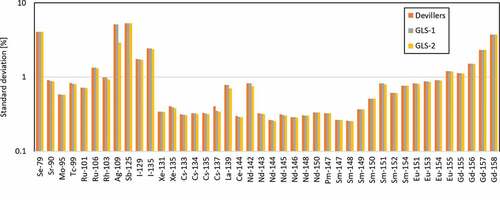
shows fissile nuclide-wise contributions to the number density uncertainties.

